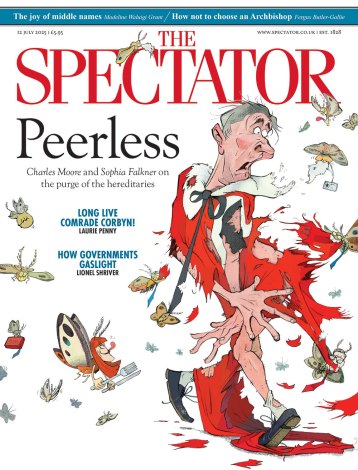Gianlorenzo Bernini stressed the difficulty of making a sculpture of a person out of a white material such as marble. Imagine, he said, that someone we knew well whitened his hair, his beard, his lips and his eyebrows, and, were it possible, his eyes. Would we recognise him? This is not a problem encountered by the 20th-century American artist Duane Hanson, whose work is on show at the Serpentine Sackler Gallery in Kensington Gardens.
Hanson (1925–96) took every possible step to make his figures mimic reality in skin, hair, clothes, accessories and surroundings. In comparison, the resemblance of waxworks to their models is much less convincing. Hanson’s creations can engender a rare type of uncertainty. Is that person over there a human being or a piece of art?
Of course mostly it’s clear enough which is which, despite all Hanson’s efforts. Total immobility is a bit of a clue. Certain details even he could not get quite right: the hair, for example, always has a shop-mannequin look. Nonetheless, one has flickers of doubt.

Approaching the middle-aged ‘Man with Hand Cart’ (1975), I wondered for an instant whether he was a weary worker paused halfway down the gallery (and I also looked twice at the black-clad woman in the corner, until she blinked and revealed herself as an attendant). Even standing close to ‘Queenie II’ (1988), an overweight cleaning lady pushing a plastic bin loaded with mops and bottles of polish and detergent, it’s possible to imagine she’s a person frozen in time by some Harry Potter-ish spell. Everything — from her clothes to the expression of desolate boredom in her eyes — is so right.
This raises the question, what’s the point? Hanson’s art leads you to muse on the justification for making such perfect facsimiles of a commodity that’s in plentiful supply. That is, ordinary people.
Quite a lot of the pleasure, it is true, comes from the fairground, I-can’t-believe-it’s-not-real aspect of his work. But these are serious works. They belong to an alternative tradition that includes the hyper-real, coloured and clothed religious sculpture of baroque Spain, and also 21st-century artists such as Paul McCarthy and Maurizio Cattelan.
The power of Hanson’s sculptures comes not from their ability to trick, but from their emotional mood. His people belong to the tradition of American melancholy, which is the flipside of all that transatlantic optimism, energy and positive thinking. ‘Old Couple on Bench’ (1994), gazing out vacantly into space, are cousins of the lonely figures in the paintings of Edward Hopper, who seem isolated even when in company.

I chose right, and almost immediately entered a long, winding and almost completely pitch-black corridor. Feeling a slight responsibility as I was followed by a group of young people — who alternately shrieked with pleasurable alarm and reassured each other — I edged forward through the darkness for what seemed like a very long time. It was a disorientating and not entirely pleasant experience.There are more amusement park-type attractions over at the Hayward Gallery, where there is a survey of work by the German/Belgian artist Carsten Höller. It is entitled Decision, and the first one visitors must make is which of two entrances — right or left — to take.
That, it seems, is what Höller wants you to feel. He is after what Rimbaud called ‘le dérèglement de tous les sens’, a venerable romantic aim. And he invites you to feel that loss of control through such stratagems as exiting the Hayward down a long snake-like slide from roof to entrance level, being suspended in a horizontal position from a rotating gantry to give the impression of flight, and wandering around on a terrace of the Hayward wearing a mirrored contraption on your head that turns your visual field upside-down.

Fun? Well, I suppose it is if you like that sort of thing — and also if you enjoy queuing. All the above attractions involve a lengthy wait for your turn, or did when I paid my visit. On the other hand, they seem rather more interesting than the works for which no lining up is required — for example, a merry-go-round carrying sculptures of giant fungi (magic mushrooms, perhaps).
I don’t think that Höller’s project, which is to ‘induce hallucinations, in the widest sense’, really works. He wants visitors to lose control by shooting down his slides, for example, instead of contemplating their forms in the orthodox manner. But art requires a bit of distance and a chance to contemplate — if not, you’re doing something else, which Disney World might do better.

Back in Kensington Gardens, there is something for those who prefer a bit of old-fashioned contemplation in an exhibition of paintings by Lynette Yiadom-Boakye at the original Serpentine Gallery. In art-world terms her unique selling-point is that she works in an idiom reminiscent of Manet’s, but her subjects are almost all black people (she was born in London, of parents who originally came from Ghana).
Her work is so traditional, in other words, as to seem paradoxically cutting-edge — especially as it depicts a group who have not often been represented in western painting. She has a nice touch, a pleasure in paint and in painting rapidly (most of her works are done in a day). Pictures such as ‘Any Number of Preoccupations’, its sitter clad in a red dressing-gown against a dark shadowy background, reveal a rich sense of colour. There’s plenty here for those who prefer to look at a good painting rather than whizz down a spiral tube.





Comments